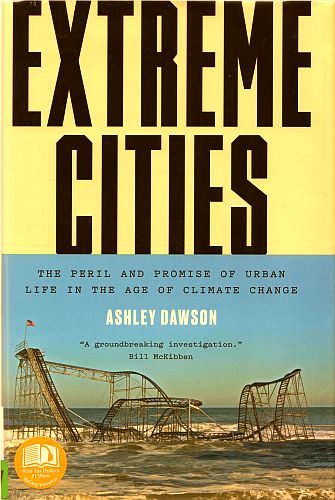

| EXTREME CITIES The Peril and Promise of Urban Life in the Age of Climate Change Ashley Dawson London: Verso, October 2017 |
Rating: 4.0 High |
|||
| 978-1-78478-036-4 | ||||
| ISBN 1-78478-036-7 | 378pp. | HC/BWI | $29.95 | |
Ashley Dawson is a Professor of English at CUNY. He undertakes here to document the present-day impact of climate change on various coastal cities.
"Scientific literature on climate change has largely ignored the disproportionate contributions of cities to global warming, while climatology tends to assess the threat on a global scale and in the future tense, often in terms of how much the planet as a whole will warm by 2100, for instance. As a result scientists actively suppress specific information about climate change in cities, statistically adjusting data collected from urban weather stations in global temperature datasets. In seeking to record the overall fluctuations of a planetary environment, science ignores the specific places where most of us live—cities—which also happen to be the sites of the most extreme transformation. This makes climate change seem distant and abstract, something that will happen in a remote future on a scale far removed from that of individual experience." – quoted on page 7 |
I don't think this is intentional obfuscation. But it does reveal Dawson's limited understanding of science in general and climatology in particular. Global warming affects the whole globe, and climatology quite properly looks at the related phenomena on the largest scales. Also, modeling works better on those scales, and is far from attaining reasonable accuracy at the regional scales, let alone city level.
That said, the book imparts a great deal of information about environmental changes in specific cities: most notably New York City, but also Jakarta, Miami, and others. Dawson pushes his examination down to the neighborhood level and back into history. The result is valuable, but also overwhelming. Few readers interested in the lost wetlands of Jamaica Bay, for example, will need or want to be told how people in previous centuries viewed swamps as vile sources of disease-causing vapors that were better eliminated.
Ashley Dawson has a good grasp of ecology but he probably understands climate science less well than he should. That's no great handicap in this book , however, because he focuses on promoting the policies that will assure long-term sustainability of coastal communities — mainly restoration of wetlands. I would not recommend that non-specialists should read the entire book, but they should read the conclusion. The book has extensive endnotes that are a rich source of further reading. Its index is reasonably well done. I'll give it a score of 4.0.

 To contact Chris Winter, Send email to this address.
To contact Chris Winter, Send email to this address.